How To Prevent And Treat Nutrient Lockout In Cannabis

- 1. What is nutrient lockout?
- 2. What causes nutrient lockout?
- 2. a. Inappropriate ph levels
- 2. b. Nutrient build-up in the medium
- 3. How to identify nutrient lock and symptoms?
- 4. How to prevent nutrient lockout?
- 5. Other nutrient-related issues that can affect cannabis plants
- 6. How to treat nutrient lockout?
- 7. In conclusion
Nutrient lockout (or nutrient lock) is caused by the pH levels when not measuring it properly, by an excessive feeding when you're watering your automatic or feminized seeds with a higher dose of nutrients, if you don’t take the right care your plants will start to grow slowly, show deficiencies on the leaves and ultimately die. This is a very common issue that novice growers face, as it is easy to fall into the trap of thinking that adding just slightly more nutrients than the bottle advises will translate into faster, healthier, more vigorous growth. But, the opposite is actually true. In general, we suggest always slightly lower the bottle dosage amounts, and us a TDS or EC pen to check the nute levels in your feed water before letting the thirsty girls drink.
1. What is nutrient lockout?
Nutrient lockout is when the necessary macro and micronutrients are present in the medium but your plant cannot absorb them because the medium is saturated or because of higher (or lower) pH levels, this it can happen in all types of mediums and your plant will start signs of nutrient deficiency.
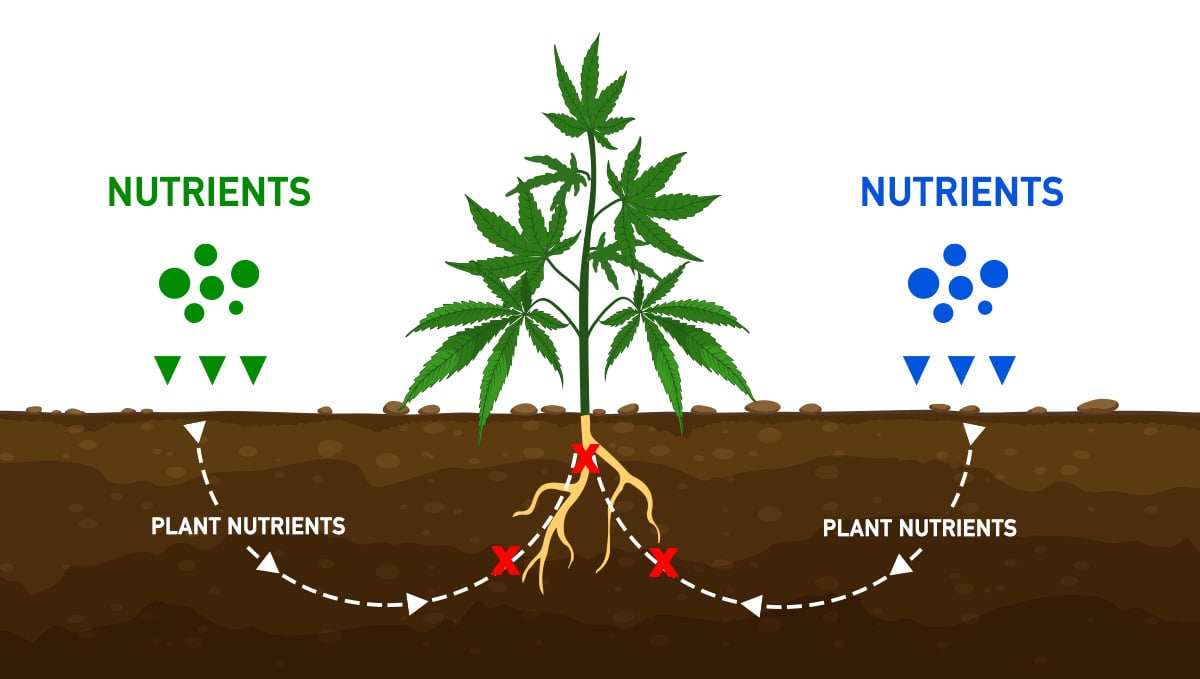
This is a very common problem growers encounter when using a new nutrient brand and especially when using synthetic nutrients, a nutrient lockout will inhibit your plant from absorbing the nutrients it needs to develop and it can ultimately kill your plants if you don’t find out what's wrong with them. Synthetic nutrients are fast-release, meaning that the nutrients in the solution are almost instantly available for the roots to uptake.
This comes with some huge upsides - like being able to treat deficiencies almost immediately, but it can also cause an excess of nutrients to build up and coat the roots.
This creates a shield-like barrier which can actually cause the pores to become blocked and can also cause the pH levels in the medium to vary. When this happens, the plant will struggle to uptake the needed levels of nutrients, resulting in a nutrient lock situation. This is a rarely seen issue for growers using organic fertilizers, as organic compounds take time to break down and release the trapped nutrients.
2. What causes nutrient lockout?
Nutrient lock can happen because of two things:
Inappropriate Ph levels
The pH level is what determines which nutrients your plant is able to absorb, that’s why it’s so important to not only check the pH of your nutrient solution but also the pH level of the medium you’re growing in. The pH level varies depending on the medium you’re growing in and the only way to measure it is with a pH meter, so it’s essential to have one if you want to avoid problems, although you can grow cannabis without one but it will be harder to figure out what’s wrong if you encounter problems along the way. One of the most important bits of kit for any grower is an accurate pH meter.
These come in many different shapes and qualities, but choosing the right one can save you huge headaches in the future. A great general rule to follow when buying anything related to weed cultivation is to spend a bit extra. The market is flooded with low-quality alternatives, but buy purchasing good quality kit you give yourself the best chance of growing huge, dense, delicious, ultra-sticky buds.
Nutrient build-up in the medium
Because nutrients are minerals, the excess of nutrients in the medium can increase the pH level in the medium and this can inhibit nutrient absorption. To avoid this, it’s better to use organic nutrients or really control how much and how often you feed your plants, remember that cannabis plants need a certain amount of nutrients, feeding more or less will result in nutrient deficiency. High-quality EC meters may cost a little more than the low-quality crap found all over the internet, but as we have mentioned above, it's best to buy a quality kit for cannabis growing.
3. How to identify nutrient lock and symptoms?
Identifying nutrient lockout can be kinda hard because the symptoms shown will be the same as when overfeeding or when there are nutrient deficiencies, like:
- Weak plants
- Stunted growth
- Yellowing leaves
- Leaves curling
To make sure your plants are suffering from nutrient lockout and not anything else, you must first check the pH level of the nutrient solution you’re feeding your plants and the medium they’re in.
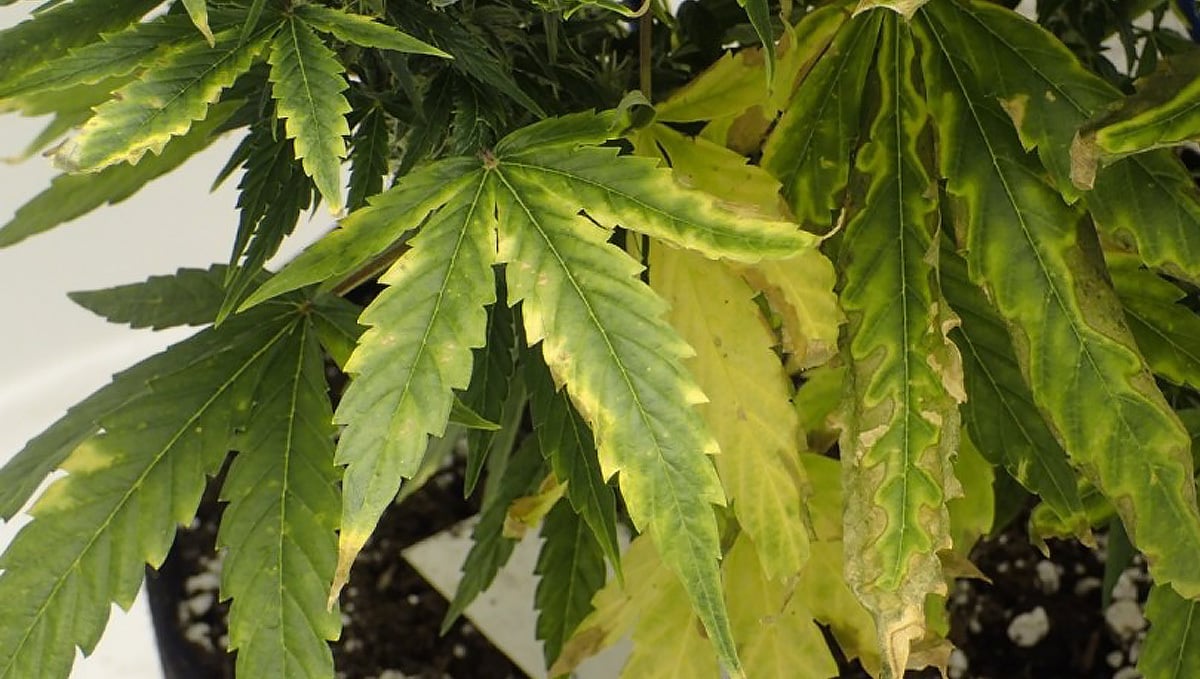
You need to check both of them because sometimes the nutrient solution has the correct pH but there are nutrients accumulated in the medium, so even if you’re feeding your plants a pH nutrient solution, they won’t be able to absorb them.
There are two ways to do this and how you do it depends on the tools you have available, obviously you will need a pH meter but some of them allow you to check the soil and others don’t so you can check the soil’s pH directly or measure the run-off after watering your plants.
When measuring the run-off, the pH level of the water coming out of the pot is the pH level in the soil so if it comes up too high it means the medium has a nutrient build-up.
4. How to prevent nutrient lockout?
There’s nothing extra to do to prevent nutrient lockout other than growing with caution, with these three tips and keeping an eye for the signs your plans give you you’ll avoid any problems.
Check pH daily
Depending on the medium you’re growing in, you’ll have to check the pH daily or even multiple times a day, in hydro the roots are directly in the nutrient solution so you have to check it a couple of times a day while in soil you’ll be fine by checking the soil and the nutrient solution once a day.

If you need to adjust the pH, you can buy a pH Up or a pH Down solution at your local growshop or even adjust it naturally with lemon juice (decrease the pH) or baking soda (increase pH).
Use organic nutrients
Another good way to prevent it’s using organic nutrients, and unlike synthetic nutrients, organic nutrients make the minerals available in the medium for your plant to absorb them when they need to instead of feeding the roots directly.
If you wanna keep using synthetic ones, make sure you use good quality nutrients and always check the pH and amount of nutrients you provide in every watering, have in mind that in most cases the recommended dosage the manufacturers advise is too high, so if you don’t have a TDS meter you’ll have to decrease the dose manually.
| Stages | Nutrients |
|---|---|
| Seedling | Water |
| First half of the Vegetative stage | ½ dose of Veg. Nutrients |
| Second half of the Vegetative stage | 1 dose of Veg. Nutrients |
| Pre-flowering stage | ½ Veg. Nutes + ½ Flowering Nutes |
| First half of the Flowering stage | ½ Flowering Nutes |
| Second half of Flowering Stage | 1 dose of Flowering Nutrients |
| Ripening and Harvest | Flushing (water) |
You can follow the chart above to make sure you’re not overfeeding your plants, just remember that this is approximate and you should see how your plant develops to increase or decrease the nutrients.
Flush your plants
If you wanna be sure nothing happens, you can always flush between the vegetative and flowering stage although it is not obligatory but will ensure there is no excess to cause nutrient lockout when going from one stage to another.
5. Other Nutrient-Related Issues That Can Affect Cannabis Plants
Okay, so we have thoroughly gone over everything relating to nutrient lockout, but how about other nutrient-related issues that can strike crops?
There are two other main problems that new growers often face, especially when growing with nonorganic cultivation methods - hydroponically, or in coco-coir. Sure you can run both of those systems with organic nutrients, but the huge majority of soil-less cultivation methods are going to be using fast-acting synthetic nutrients. Now don't get us wrong, these cultivation styles are absolutely amazing, and a true testament to man's ingenuity. But they do come with some issues that you, as the cultivator, need to totally aware of.
Why are these such common issues for beginner growers?
It's simple. Synthetic nutrients are ridiculously potent, and if you do not take the proper precautions when using them, you can easily get things wrong. So many new growers seem to think it's fine to not check both the pH and EC levels in their feed water. This probably comes down to the fact that they have been told or read this isn't 100% necessary when growing organically in a soil-based medium (although still recommended). But with soil-less, non-organic methods these measurements are 100% crucial to the health of your crop, and just cannot be skipped.
And then there's the old issue with the recommended dosages on the bottles. You have to remember those nutrient companies are just that - companies, which is just another name for businesses. And how do they make money? by selling more nutrients...So, it should come as anything but a surprise that the dosages offered on the side of the bottles are sometimes, well, inflated slightly. Before you go down the synthetic nutrient route, it is important to read some in-depth articles and grow diaries discussing the actual dosages of the specific nutrient range you are wanting to use. This ensures you get an unbiased, real-world idea of the adequate dosages.
How does this all relate to over and underfeeding?
Well, simply put, if you don't know how much to feed your crop, then how in the world are you supposed to get the dosage right? And if you don't get the dosage right, you are going to run into either over or underfeeding issues sooner rather than later. That's why it is so important to do your research, obtain proper pH and EC meters, and understand the actual dosages of nutrients that you are using. This knowledge will allow you to make sure your plants are getting all the nutrients they need, and in the correct dosages.
Which brands of nutrients should you be using?
Take just a peek online at the options and you're sure to be overwhelmed pretty quickly. The list of nutrient companies is really long and is only getting longer every single year. But, if you're looking for a brand to trust, it's hard to go past Advanced Nutrients, CANNA, Fox Farms, GHE, House & Garden, or Cyco. That's not to say that there aren't a bunch of other fantastic options out there, just that these are all well-established brands that have proven time and again to offer the very best in cannabis nutrition.
How about additives?
Once you've chosen the base nutrient schedule that you want to run, it's time to decide if you want to also include some additives. Now, these are definitely not necessary, but if you wanna get the best results possible you should consider a few options.
- A root health additive is recommended, and one that contains beneficial bacteria and fungi is also a great choice. We personally like the range from GHE, but there are many other options out there.
- A sweetener is another option to consider in your arsenal of nutrients and additives, as this will help with the taste and smell of your crops come harvest time. Quite often, growers just use plain molasses, but there are some nutrient companies that offer specific sweetener nutrients.
- A flowering booster is also a good idea.
6. How to treat nutrient lockout?
The first thing to do after identifying nutrient lockout is to stop adding nutes to the feed water immediately and flush your plants. So how many times should the plants be flushed? This is a tricky question to answer, as it is dependent on the medium you are using to grow your crop. Pure hydro setups are easily and quickly flushed, whereas crops grown in a soil mix may take multiple flush runs to clean out the medium totally.
The amount of times you will need to flush is also dependent on the level of nutrients in the medium, it can take a couple of flushes to completely remove them so you will need to measure the medium until the run-off (or soil) has the correct pH, this is the only way to treat nutrient lockout, if you don’t have a pH meter then you will have to do it until your plant is back to normal.
The best pH level in your case will depend on the nutrients you’re using, your environment and the strains you’re growing but you can use this chart as a guideline.

When doing this it’s a good idea (if you are growing indoors) to decrease the humidity level in your growing space because the humidity can go up and it will stress your plants even more. The water you’re flushing with needs to be pH’d and the right pH level will depend on the medium you’re growing in. You should flush a few times with the lights turned on, and then wait for the light cycle to switch to darkness before again giving the plants another good flush. Remember to check the pH level of the medium or runoff after each flush to get an idea of where the pH is sitting. You can also use a TDS or EC meter to check the nutrient levels in the runoff.
| Medium | Ph Level Range | Optimal Range |
|---|---|---|
| Soil | 5.5-7.0 | 6.0-6.8 |
| Hydro and Soilless | 5.5-6.5 | 5.8-6.0 |
7. In conclusion
A nutrient lockout can be caused by overfeeding but is really caused by the pH level of your solution and medium, this is a really common problem with new growers so make sure you’re feeding your plants properly. If you’re dealing with this kind of problem and need advice or want to help us by giving tips, please leave a comment below!
This post was most recently updated on April 22, 2022.








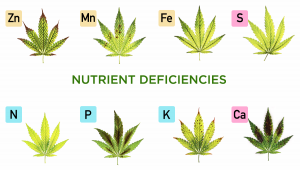

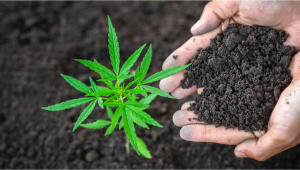
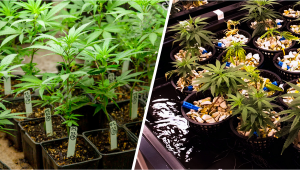
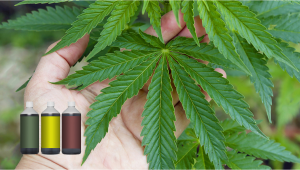
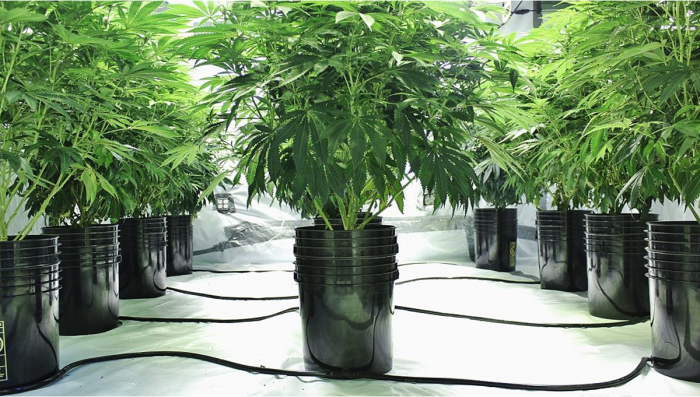

Comments